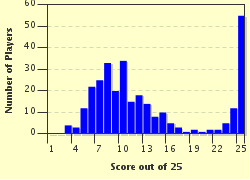Quiz Answer Key and Fun Facts
1. Name the subfamily that includes the milk snake.
2. This animal, which is supposed to have disappeared off the face of the earth between 40,000 and 30,000 years ago, was a massive predator often 7 metres long and weighing 620 kg. Scientists assume that due to its appurtenance to the Varanid lizards family it might have also been venomous. If so, then this was the largest viperous vertebrate ever known.
3. Hyenas are more closely related to cats and mongooses than to dogs or wolves.
4. The Karakachan dog - one of Europe's oldest breeds - descends from the dogs of which people?
5. This cat breed is characterized by its elongated robust body, long legs and bushy tail. The profile is generally straight, the eyes - almond-shaped and oblique (their color varies a lot). Due to a tuft of hair the ears resemble those of a lynx. Strong claws make these cats good climbers (they can even scramble rocks).
6. The smilodon - a kind of saber-toothed cat - lived on the territory of which two continents?
7. Which of these big cats is on average the largest kind?
8. Which of the following is not true about the archaeopteryx?
9. The extinction of what animal in 1936 led to the Tasmanian devil becoming the largest carnivorous marsupial in the world?
10. Which is not true about the binturong?
11. Based on nuclear studies, the closest living relatives to phorusrhacidae (known also as terror birds) are birds such as:
12. Apex predators are always and exclusively hypercarnivores.
13. How many are the extant species of hyena?
14. What is true about the moa bird?
15. Crows and ravens are not distinguished by:
16. Which is not true about the Finnish lapphund?
17. In 2013, a zoo in China tried to cheat its visitors by passing off another animal as a lion. What was the animal?
18. Which rhinoceros subtype has a single horn instead of two?
19. Which is not true about the giant otter?
20. In Japan the number of people losing their lives after being attacked by the giant hornet exceeds this of the victims of homicide (by other people).
21. What kind of animal was the megalonyx?
22. This constrictor snake's maximum length is eight feet. Its prey consists mainly of birds, frogs and small mammals. Young representatives of the species are orange during the first year of their existence. These snakes have slower metabolism and can go for months without food.
23. The lions of Tsavo, which are said to have killed 135 men (most of them construction workers on the Kenya-Uganda railway) between March and December 1898, had no mane. Why?
24. The yak is a large herbivore which inhabits the wild areas of the Himalayan region, the Tibetan plateau and northern territories like Mongolia and Russia. The English "yak" derives from the local Tibetan word "gyag". As opposed to English, where "yak" is used as a reference to both male and female representatives of the species, in Tibetan "gyag" is used only for male animals. What word denotes females?
25. The largest verified captive Kodiak bear in the 20th century weighed nearly 1,000 kilograms.
Source: Author
blackandgreen
This quiz was reviewed by FunTrivia editor
Tizzabelle before going online.
Any errors found in FunTrivia content are routinely corrected through our feedback system.

